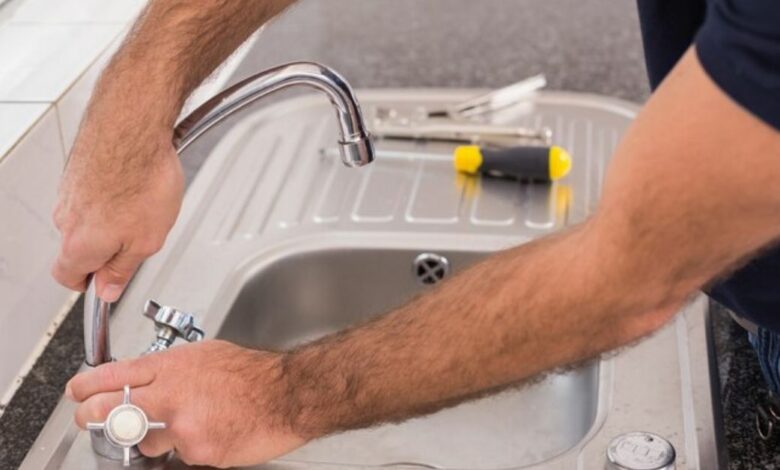How to Install a Pull-Down Kitchen Faucet on Sink

Installing a project source pull-down kitchen faucet involves mounting a faucet with a retractable sprayer. In this guide Faucet Fixed help you about fitting and securing the new faucet onto the sink deck. You connect the hot and cold water supply lines properly. Finally, you test for leaks and ensure smooth functionality.
Transform your kitchen with a modern touch: imagine effortlessly switching between stream and spray. Picture yourself with access to a pull-down sprayer. Start your journey with a pulldown kitchen faucet, from Project Source.
Pre-Installation Preparation
Alright, let’s get organized before we start wrenching away.
Gathering necessary tools and materials
Before you start, ensure you have all the tools and supplies mentioned in the manual. You’ll need a wrench, plumber tape and a bucket to catch any water that may leak.
Shutting off the water supply
Let’s make sure we prevent any surprise waterfalls by shutting off the water supply to the kitchen sink. Find those valves. Turn them clockwise until they’re securely closed.
Clearing the workspace
Time to declutter! Clear out the sink and surrounding area to give yourself ample space to work. No one wants to accidentally knock over a jar of pickles while installing a faucet!
Removing the Existing Faucet (If Applicable)
It is the important first step in the process of upgrading your kitchen. Follow our comprehensive guide on how to remove a kitchen faucet to ensure a smooth transition to your new fixture.
Turning off water supply valves
Make sure you give those shutoff valves a look to make sure the water flow is completely stopped. We wouldn’t want any issues when we begin disconnecting everything.
Disconnecting water supply lines
Grab your adjustable wrench and start loosening those water supply lines. Keep a bucket handy to catch any drips or spills. And remember, hot goes with hot, and cold goes with cold!
Removing the old faucet
With the water lines out of the way, it’s time to say goodbye to the old faucet. Loosen those nuts secure them to the sink and gently lift them out. Watch out for any lingering grime!
Installing the New Project Source Pull Down Kitchen Faucet
Now for the exciting part bringing in the shiny new faucet!
Assembling the new faucet components
Unpack that box of goodies and lay out all the pieces. Follow the instructions carefully as you assemble the faucet. It’s like putting together a puzzle but with fewer missing pieces (hopefully)!
Positioning the faucet correctly on the sink
Gently place the faucet that you’ve put together into the hole on the sink counter. Ensure its positioned in the centre and aligned perfectly to your liking. Taking your time with this step will definitely pay off.
Securing the faucet in place
Once the faucet is in position, it’s time to lock it down. Use the provided mounting hardware to secure it tightly to the sink. Just be gentle – we want a snug fit, not a cracked sink!
Connecting Water Supply Lines
Let’s get the water flowing again but this time, through our brand-new faucet!
Attaching hot and cold water supply lines
Grab those water supply lines and attach them to the corresponding valves. Remember to use the plumber’s tape for a watertight seal. And don’t forget to give them a good tighten with your wrench!
Ensuring tight connections
Make sure to inspect, confirm and reconfirm all the connections to ensure they are properly secured. The last thing we need is a leak that could spoil all the effort we’ve put in.
Testing for leaks
Time for the moment of truth – turn those water supply valves back on and keep an eagle eye out for any leaks. If you spot any, don’t panic! Just tighten up those connections a little more until they’re leak-free.
Additional Considerations
Almost there! But before we call it a day, let’s cover a few extra bases.
Installing additional features (soap dispenser, water filter)
If you’ve got any extra bells and whistles to install, now’s the time to do it. Follow the manufacturer’s instructions carefully to ensure everything’s set up just right.
Checking for proper functionality
Try out the faucet by using the pulldown sprayer adjusting the temperature and ensuring that everything is functioning correctly. It’s similar, to test driving a car with less power, under the hood.
Troubleshooting common issues
Had a snag on your journey? No need to fret, it’s just part of the experience. Take a look at the problem solving manual. Get in touch with customer service for some guidance. We’ll have that faucet running smoothly in no time.
Conclusion
Setting up a project source pull down kitchen faucet can be a do-it-yourself endeavor. By following the step-by-step instructions you can enhance both the functionality and appearance of your kitchen. With preparation and attention to detail you’ll appreciate the benefits of an installed faucet for many years to come.
The installation procedure includes preparing the workspace, removing the existing faucet and securely installing the one. Connecting the water supply lines and checking for leaks ensures everything operates smoothly. Adding features like a soap dispenser or water filter can further improve your kitchen’s efficiency.
Take pride in your fitted faucet. Relish the added convenience it provides. Whether its washing dishes or filling up pots your kitchen chores will become simpler with a project source pull-down kitchen faucet. Through installation and maintenance, this small upgrade can have an impact on your daily routine.
Frequently Asked Questions
Which tools will I need to set up a pull-down kitchen faucet?
You’ll require some tools, like a wrench and plumber tape. It’s also useful to have a basin wrench on hand. Don’t forget to have a bucket to catch any water that might drip.
Is it necessary to turn off the water supply before putting in the faucet?
Yes, it’s crucial to turn off the water flowing to the kitchen sink before you start installing the faucet. Locate the shut-off valves. Turn them in a clockwise direction until they are completely closed.
How can I ensure that I’m connecting the hot and cold water lines correctly?
Typically the hot water line is situated on the side while the cold one is, on the side. Be sure to match these lines during installation to prevent any confusion.
What steps should I take if there are leaks after I’ve installed the faucet?
In case you detect any leaks, review all connections carefully to confirm they are properly tightened and secure. You might need to use your wrench for tightening until no more leaks occur.



